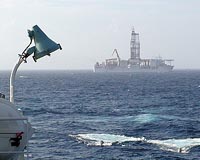| . |  |
. |
Paris (AFP) Sept 30, 2009 Huge earthquakes can weaken seismic faults on the other side of the world, scientists in California said on Wednesday. Their study coincided with a major 8.0-magnitude quake in the Pacific, unleashing a tsunami that killed scores of people in the Samoan islands and Tonga. Seismologists led by Taka'aki Taira of the University of California at Berkeley found that the 9.1 monster that struck west of Sumatra in December 2004 weakened a closely-monitored segment on California's San Andreas fault, 8,000 kilometers (5,000 miles) distant. Their investigation is based on a scan of 22 years of data from the Parkfield area, a district so studded with borehole seismometers and other gauges that it has been dubbed "the earthquake capital of the world." The monitors found that areas of fluid-filled fractures lie within this section of the fault. Driven by seismic pressure, the fluid migrates along the fault like spidery veins in marble, acting as a lubricant that enables shocks to pry open the rock, they believe. Proof of this suspicion came with the finding that repetitive background quakes became smaller and smaller during periods of fluid shift -- in other words, as the fault slowly weakened, less energy was needed to shake it. But the most remarkable finding was unexpected impacts from two big, distant quakes -- a 7.3-magnitude shake near the Californian town of Landers in 1992 and the 2004 Sumatra behemoth that unleashed the Indian Ocean tsunami. Almost five days after Sumatra event -- one of the biggest quakes in recorded history -- sensors noted dynamic stress on the Parkfield fault at a depth of five kilometres (three miles). The study, published by the British weekly science journal Nature, provides compelling support for a novel theory that very big quakes can have a cascade effect elsewhere, sometimes months afterwards, say the researchers. "The long-range influence of the 2004 Sumatra-Andaman earthquake on this patch of the San Andreas fault suggests that many of the world's active faults were affected in the same way, thus bringing a significant number of them to failure," the study says. "This hypothesis appears to be supported by the unusually high number of quakes of magnitude eight or above occurring in the three years" after the 2004 event, it said. "No other large earthquake, of magnitude eight or more, since 1900 was followed by as many for a comparable period," it observed. The team hopes their work will yield a technique for assessing the strength of a seismic fault -- testing whether it has the strength to resist a shock or rip apart and threaten human life. Discreet changes in the seismic wave, corresponding to periods when the numbers of small earthquakes intensifies, can be quantified into a means of pinpointing faults that are likely to fail, Taira believes. Predicting when earthquakes will strike remains an over-the-horizon prospect, although strides have been made into assessing how stress builds up in a fault deep underground. "Earthquakes are caused when a fault fails, either because of the buildup of stress or because of a weakening of the fault," said Taira in a press release. "Changes in fault strength are much harder to measure than changes in stress, especially for faults deep in the crust. Our results open up exciting possibilities for monitoring seismic risk and understanding the causes of earthquakes." Share This Article With Planet Earth
Related Links Tectonic Science and News
 New Evidence Relates To Origin And Evolution Of Seismogenic Faults
New Evidence Relates To Origin And Evolution Of Seismogenic FaultsWashington DC (SPX) Aug 21, 2009 New research about what triggers earthquakes, authored by Michael Strasser of Bremen University, Germany, with colleagues from the USA, Japan, China, France, and Germany, will appear in the Aug. 16 2009 issue of Nature Geoscience (online version). The research article, titled "Origin and evolution of a splay-fault in the Nankai accretionary wedge" is drawn from the ... read more |
|
| The content herein, unless otherwise known to be public domain, are Copyright 1995-2009 - SpaceDaily. AFP and UPI Wire Stories are copyright Agence France-Presse and United Press International. ESA Portal Reports are copyright European Space Agency. All NASA sourced material is public domain. Additional copyrights may apply in whole or part to other bona fide parties. Advertising does not imply endorsement,agreement or approval of any opinions, statements or information provided by SpaceDaily on any Web page published or hosted by SpaceDaily. Privacy Statement |